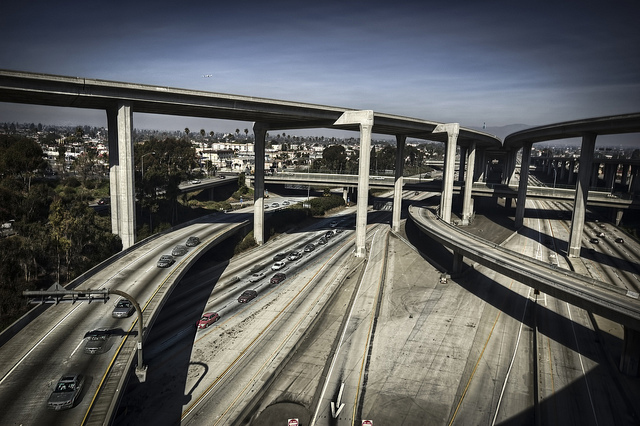Caltrans Must Consider Community’s Alternative to the I-710 Freeway Widening Project that Actually Reduces Pollution and Environmental Injustice.
May 5, 2014
By Maya Golden-Krasner, CBE Staff Attorney
Caltrans appears determined to widen an 18-mile stretch of the I-170 freeway from the Ports of Long Beach and Los Angeles. The project affects 19 cities in addition to unincorporated areas, and could cost up to (or over) $5 billion. This is a major undertaking, and the surrounding low-income communities of color must see benefits from the project. Residents who want more than just the status quo of paving a freeway through their neighborhoods have spent significant time and resources participating in the project’s cumbersome public process, and even proposed and developed “Community Alternative 7” (“CA7”).
CA7 is an integrated and comprehensive project alternative. Despite significant support for analyzing this alternative, however, Caltrans now refuses to consider it in its entirety, and has become increasingly antagonistic to community concerns or involvement in the project. The question has now become: Will Caltrans analyze CA7 in the recirculated Environmental Impact Report/Study (EIR/EIS), or will it continue its history of running roughshod over the low-income communities of color who are forced to bear the brunt of freeway projects’ impacts?
Expanding the 710 freeway has been and remains an act of environmental injustice.
East LA boasts the largest percentage of land covered by freeways in LA, and their construction served to perpetuate poverty and racism by displacing families and businesses, and dividing existing communities. A large body of evidence shows that freeway traffic causes and worsens pulmonary and cardiovascular diseases and cancer in people who live and go to school near freeways. Caltrans, however, refuses to acknowledge the social impacts of the 710 expansion, and generally dismisses the air impacts.
Caltrans’ lack of just and forward thinking is even clearer when compared to another freeway project—one that runs through a much whiter, wealthier community (and includes the likes of Bill Gates!) in and around Seattle. The SR-520 freeway widening project alleviates community impacts using, among other strategies, soundwalls, quieter pavement, and landscaped lids. The lids serve not only to reduce noise, but also to “reconnect neighborhoods, enhance movement of pedestrians and cyclists, restore and create views, and provide access to … transit stops.” Additionally, the SR-520 project includes a bicycle/pedestrian path to connect to existing paths and public transit.
By contrast, Caltrans’ single noise mitigation was soundwalls, and even then it found some too expensive, even in critical places (like next to schools). Caltrans did not even analyze landscaped lids to reconnect communities, enhance movement of pedestrians and cyclists, or provide access to existing or new transit stops. Indeed, the DEIR/EIS for the I-710 failed to include any real plan for enhancing public transit or pedestrian/bicycle movement at all. Why should Medina get these benefits but not Southgate?
As we recently explained in a letter to Caltrans, as a state agency receiving federal funds for the project, Caltrans is under an obligation under federal and state law not to discriminate against people of color. It must prevent disproportionately high and adverse human health or environmental effects on minority and low-income populations. The federal Department of Transportation suggests this can be done by, for example: “providing offsetting benefits and opportunities to enhance communities, neighborhoods, and individuals…,” and “[c]onsidering alternatives ….where such alternatives would result in avoiding and/or minimizing disproportionately high and adverse… impacts.”
LA’s communities have offered an alternative that would do exactly that, an alternative that can be used as model for other 21st-century transit projects. Caltrans must expand its myopic view of “project” to include not just building more freeway lanes, but also as an opportunity for building and revitalizing the communities the freeway helped disrupt. Caltrans must pull its head out of the sand, stop paying lip service to its obligation to listen to the communities that house the freeway, and consider this alternative as a complete and comprehensive project—not just for the sake of local communities, but to improve the air quality for all Angelenos.
CBE, as part of the Coalition for Environmental Health and Justice, has been working on this project since 2002. We have a good deal of information about Freeway Expansion and Community Alternative 7.
The main elements of CA7 are:
- zero-emission freight transport,
- LA River improvements (the 710 freeway runs along the LA River),
- public and bike/pedestrian transit plans to alleviate the need for more car traffic lanes,
- community enhancements such as, among others, greening adjacent streets and the LA River corridor (and air filtration systems for nearby sensitive sites), and
- targeted hiring for low-income residents.
Here are some additional interesting facts:
- The 18-mile widening project could cost around $5 billion. The massive Keystone Pipeline project is estimated to cost approximately $5.4 billion.
- Much of what is written about the history of the 710 and other freeways in East LA is from Gilbert Estrada, and you can read more about the 710 here.)
- Moving to Equity provides information on the impact of transportation policies on minorities.
- Caltrans refuses to incorporate new information into its new project. For example, Caltrans has offered as mitigation measures for the elementary schools next to the freeway—soundwalls (when affordable)—is little more than Caltrans offered Soto Elementary School when it ran the Santa Ana Freeway through part of the schoolyard seventy years ago. (See Estrada, “If You Build it, They Will Move: The Los Angeles Freeway System and the Displacement of Mexican East Los Angeles, 1944-1952,” Southern California Quarterly (Fall 2005) 87(3): 287-315.)
photo credit: Neil Kremer



